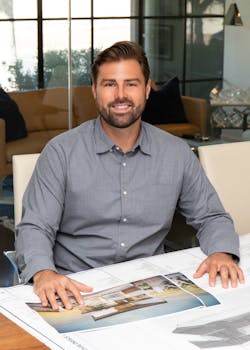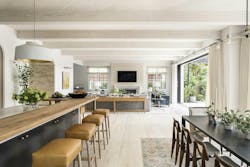Ryan McDaniel says he wasn’t fated to be an architect. He simply stumbled into it, as he puts it.
The student group stoked his interest and soon McDaniel was signing up for architectural classes. Those classes led to more classes, which led to interactions with learned professors and eventually architects in the field that ultimately set McDaniel on a path that would lead him not only to become an architect but an architect with a specific goal: sustainable building.
Today, McDaniel is a LEED AP BD+C-certified architect and a partner and design director at Brandon Architects, in Costa Mesa, Calif.
Custom Builder: You went to the University of Oregon, a leader in sustainable building. Talk to me about sustainability. When did you decide that, as an architect, you wanted sustainability to be a key part of your projects?
Ryan McDaniel: I really enjoyed my experience at University of Oregon. When you talk about sustainability, that was a strong foundation. Oregon has been a kind leader in that field for years.
But as far as architecture and sustainability go, for me, the two are fundamentally integrated. Sustainability, I think, has to be a part of any architect’s ethos. That's what we do. We design and we problem solve. We address built conditions and built challenges—whether that's new construction or a renovation. And we approach that with deductive reasoning, breaking down what our priorities are, what we need to address. Creative problem-solving is the ultimate answer.
I think you have to design responsibly. You have to factor in things like daylighting and ventilation, which are really important to incorporate. There are firms that take sustainability to an engineering level, and that's not my background. But I certainly rely on a lot of the reporting and evidence that comes from some of the bigger outfits that are able to put together the data. That reporting really allows us to have the measurables that influence design.
Brandon Architects relies on natural daylighting and airflow to keep homes well lit and cool without sacrificing efficiency.
Image: 20th Street Project – Manolo Langis
CB: Are there any specific barriers you’ve encountered in applying sustainable thinking to a custom home project?
RM: At the custom home level, it's challenging because oftentimes the expectation is that you're going to get a LEED-certified home as an outcome of sustainability. Regarding the socioeconomics of it, it can’t be a financial burden to get a LEED certification, otherwise it doesn't make sense. Really, sustainability requires a holistic approach to design and architecture. It has to make sense on so many different levels.
But that’s definitely a challenge we’ve had regarding our custom projects. It can be hard to get a homeowner on board with the concept of sustainability because they’re thinking of LEED certification and don’t necessarily see the direct translation to value. Though, in markets like California, there certainly is a quantifiable value to it.
I believe it’s something like homebuyers will pay an 8% premium for a LEED certified home.
CB: That’s a common problem—people misunderstanding the full breadth of sustainability. With that in mind, thinking beyond expectations, what can sustainability look like in more practical, real-world terms?
RM: That's a great question. For us, one of the major components ends up being natural daylighting. Pairing technology with that, we have the ability to control lighting in a unique way. We use home automation and a lot of active systems to shade and, in a way, control lighting. While we err on the side of more natural light, having the controls in place to filter that light or to block that light as needed can be a real help. Daylighting is something that is huge for energy efficiency. It’s nice being able to actually live in your home without feeling the need to turn the lights on. We embody that in all of our projects.
CB: How do you achieve that natural daylighting and circulation? Is it big doors and windows, the angle of the house, something else?
RM: Absolutely. Sometimes we're more limited, some of our homes are more constrained. Maybe they have a rectangular plot and there's a 3-foot setback on either side, and then there's another house right next to you. And so the orientation you get as far as the building footprint may be more limiting versus properties that are on 250 acres and you get to respond to that more directly with the building footprint. But in any context, the way that we position those windows is certainly key to the home's performance. There is also the benefit of our passive system. We do a lot with outdoor covered areas, whether that's awnings, a covered cabana, or maybe a balcony to use those components to serve more than one purpose—meaning we’re not just covering it with a trellis because it looks good; iIt’s also because that trellis passively shades an area from direct western exposure.
Because our sunsets are so flat, we do have to pair those passive systems of overhangs with some active systems. We employ some home automation, where roll-down shades can come down at a certain hour every day—and that might change seasonally. We can also use technology to study sun angles and that lighting aspect. We use Revit.
CB: Tell me about Revit.
RM: Revit's a really strong tool for us. It’s basically a model of when and where the sun is going to be. We can look at the time of year, or a different year altogether. I can go back in time, or go into the future. I can input March 1st at 3:00 p.m. and see where the sun would be relative to the property. So it really educates us because we can, in real-time, play with the sun’s angles and adjust the glazing as we need to.
We use home automation and a lot of active systems to shade and, in a way, control lighting. While we err on the side of more natural light, having the controls in place to filter that light or to block that light as needed can be a real help.
CB: What are some other practical sustainability steps you take as a home builder?
RM: Sometimes sustainability manifests itself in something as simple as upgrading a plywood floor on a second floor’s framing. Every home we do is 1⅛-inch minimum plywood, compared with the required ¾-inch, which is for the rigidity of the floor and the longevity of that system.
Also, here in California we have more stringent energy requirements, so we really get into stormwater management. When there's a major storm event, all of the roof runoff has to be collected and, depending on the area, even retained on site. Insulation and energy efficiency in our mechanical electrical systems are critical, as well as high-performing doors and windows. The operability of those doors and windows to provide natural ventilation is another key aspect. A lot of our projects are located in coastal areas, where the heating and cooling demand is a lot less, and so we have the ability to really capitalize on indoor-outdoor air circulation.
CB: Talk to me more about the walls in your homes. How do you insulate?
RM: Yeah, so you're right, it's contextual. We try in a lot of cases to do a layer, maybe 1 to 2 inches thick, of spray foam. And then we combine that with bat insulation. That usually gives us a pretty airtight insulation package that provides a higher R-value. We also use, at minimum, 2-by-6 for exterior walls. That way we can pick up additional depth versus using 2-by-4s. But it's more limiting on what R-value you're going to achieve. So when we go to a cold climate, we won't really be able to get away with any 2-by-8 roof framing like we can in California.
In those cases, we have to do a complete spray foam insulation. But that still wouldn't be enough in a cold climate. So we’re also installing 12-inch-deep rafters and coming up with an insulation package that pairs with that on a case-by-case basis.
CB: Once you wrap up a project, do you do any performance testing?
RM: Honestly, we don't, not at the custom residential level. We certainly follow up and we work with a lot of great builders who have maintenance programs. So there's things as a part of these systems where filter cloth needs to be replaced every so often and you have to maintain the equipment that's processing all this storm water. Otherwise, it'll be ineffective after a certain point. And so working with builders who actually follow up on maintenance and ensuring the home’s systems are always working properly has been a real benefit for our practice.
But as far as being able to really measure and have that post-evaluation that applies some numbers to how well some of these things performed, it's a little bit less objective and more so client driven. We ask how have you lived in the home, how has the lighting benefited you, have you had any negative experiences with some of the heat gain or solar exposure?I think that's a little bit easier to solve than really kind of collecting that data to be able to monitor and track some of the performance.
Still, I think that quantitative analysis is where we're headed. That's where we'd like to go. I don't think we have all of the answers by any means, but it's something that I'm looking to incorporate more into our practice. We're signatories of the AIA 2030 commitment, which is giving us some tools now to allow us to put together a strategic plan and start measuring and doing energy modeling on the front end, to help with some of that. So we actually have measurable success.
Every home we do is 1⅛-inch minimum plywood, compared to the required ¾-inch, which is for the rigidity of the floor and the longevity of that system.
CB: For our final question, I’d like to know where you see sustainability fitting into the future of home building—and not in terms of a personal focus but as an industry priority.
RM: That's a great question. You know, here in California we have a little more structure of where we're heading. In Los Angeles County, for instance, they recently put a moratorium on certain natural-gas appliances. So starting next month, you won't be able to get a new building permit for your home if it has certain gas appliances. So, going all electric is where I see us heading. That's an easily realized future. We have to think about what kind of systems we use, what kind of cooktops, and about our overall reliance on fossil fuels.
At the end of the day, it really is energy efficiency. I think we've come a long way and we can gain a lot more in the future. I'd love to see solar as a technology that every home has. Every home we plan for now is, at least, solar ready—whether the client plans to install them or not. That technology—solar and the batteries to back it up—I think, is where we're heading.
Ultimately, we want to reduce our carbon footprint. We want to reduce our reliance on fossil fuels. We want efficient systems at our electricity base. Beyond that, I think we need to look at our resources and, personally, I really want to challenge our side of material specifications.
We've done a lot of research into responsible forestry and alternative products to stain-grade natural wood. It's just harder and harder to justify the use of some of these natural hardwoods when we have products that are modifying softwoods, which are rapid growth and we can modify their properties to actually perform similarly to hardwood. And so, responsibly sourcing our materials is a big thing for us. You can't just accept something at face value because it looks great. I think you can have something that is of the same, or even higher, quality that comes with a sustainable story and a background that makes sense for the future, without compromising on design aesthetics.


